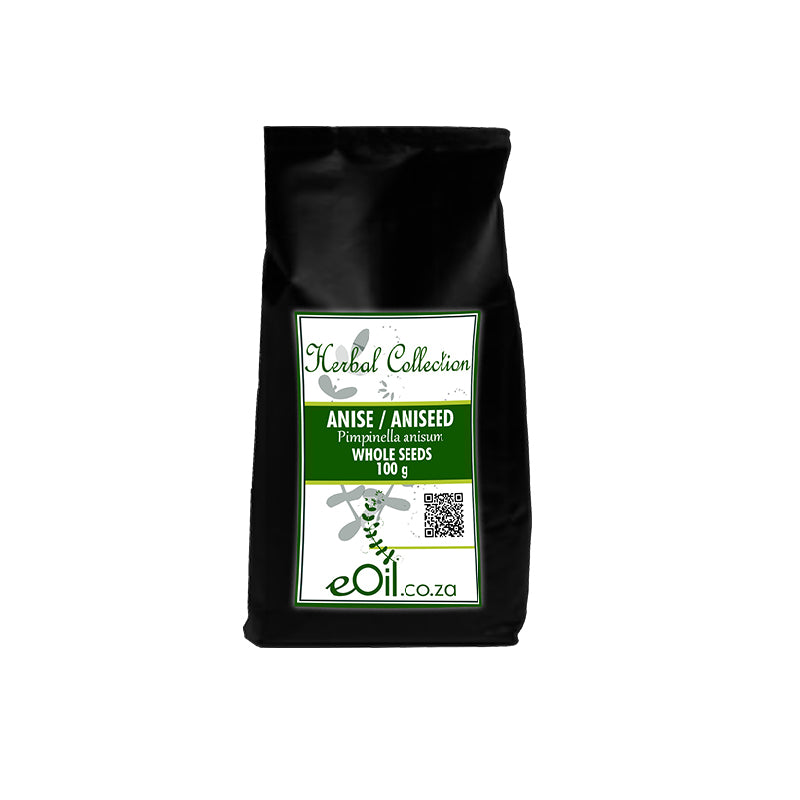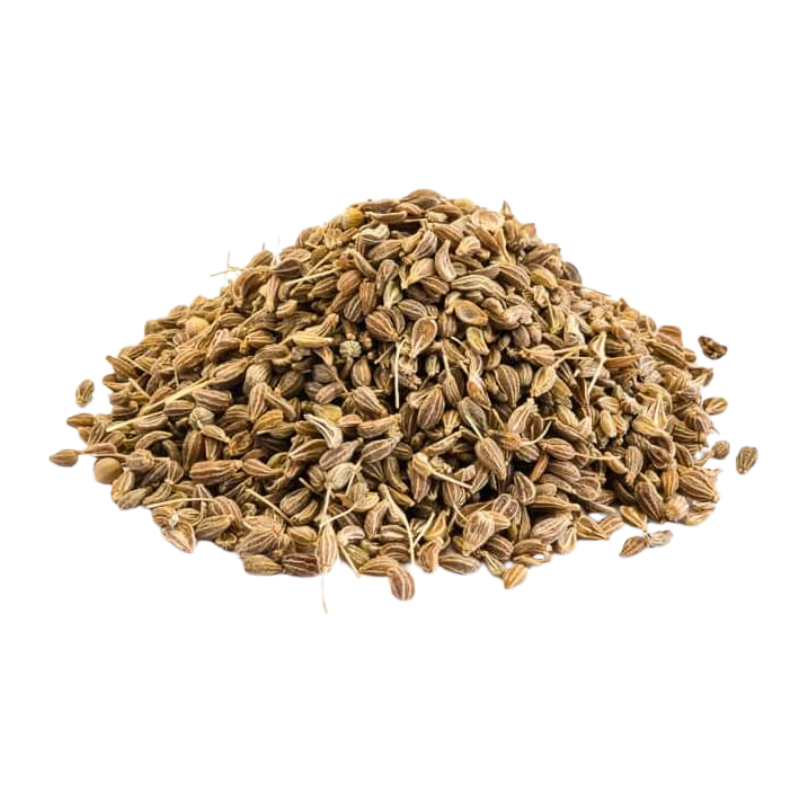Anise Aniseed Whole Dried - Herbal Collection
Anise Aniseed Whole Dried - Herbal Collection - 100 GR is backordered and will ship as soon as it is back in stock.
Description
Description
It's a classic in traditional herbalism, and its sweet, licorice-like aroma is famous.
Step into a world of traditional herbal comfort with our premium Whole Dried Aniseed.
Not to be confused with Star Anise, this is the seed of the Pimpinella anisum plant, a member of the parsley family, and is revered for its sweet, warm, licorice-like aroma and its powerful history in wellness.
As a whole, dried herb, it's the perfect, versatile ingredient for your at-home herbal preparations.
Key Traditional Uses & Applications:
Potent Digestive Soother: This is Aniseed's most celebrated use. It is a powerful carminative and antispasmodic, making it a staple for digestive health. A traditional tea (infusion) made from the seeds is used to relieve the discomfort of gas, bloating, indigestion, and colics.
Respiratory & Cough Support: Aniseed is a well-known traditional expectorant. A warm Aniseed tea is a classic remedy used to help soothe dry, spasmodic coughs and loosen phlegm, making it a great comfort during a cold or flu.
DIY Herbal Preparations:
Herbal Tea: This is the most common use. Simply steep one teaspoon of the whole seeds in a cup of hot water.
Culinary Spice: The seeds can be used whole or ground in baking (like breads and biscuits) and cooking to add a sweet, aromatic flavour.
DIY Syrups: Can be steeped as a base for homemade digestive tonics or cough syrups.
Important Cautions:
Consult a healthcare professional before use if you are pregnant, breastfeeding, or have a hormone-sensitive condition.
DESCRIPTION
Anise also called aniseed is a flowering plant native to the eastern Mediterranean region and Southwest Asia.
Flavor and aroma: sweet and aromatic characteristic flavor, close to star anise, fennel, or liquorice.
Widely used to:
- prepare of herbal teas and tisanes (seeds whole or ground).
- In Asia, the whole seeds are taken as a digestive after meals (munched)
Soothes coughs
Eases upset stomachs and flatulence
Relieves insomnia
Aniseed has stimulant and carminative properties that are said to be helpful in relieving flatulence and colic. It also loosens phlegm, fights cough, and relieves insomnia. Particularly helpful when there is persistent irritable coughing and for whooping cough.
TRADITIONALLY USED FOR
Aniseed, also known as anise, is a flowering plant native to the Eastern Mediterranean region and Southwest Asia.
The seeds of the plant have been used for centuries for their distinctive sweet, licorice-like flavor and various health benefits.
Aniseed tisane, also known as anise tea, is an herbal infusion made by steeping aniseed in hot water.
Benefits and properties of aniseed tisane:
- Digestive health: Aniseed has long been used to improve digestion, reduce bloating, and alleviate symptoms of indigestion. The carminative properties of aniseed help to relax the gastrointestinal tract and expel gas, providing relief from discomfort.
- Respiratory support: Aniseed has expectorant properties, which can help to loosen mucus and phlegm in the respiratory tract, making it easier to expel. This can provide relief for those suffering from coughs, colds, and congestion.
- Antimicrobial properties: Aniseed contains compounds like anethole, which exhibit antimicrobial activity against certain bacteria, fungi, and yeasts. This may help to support overall immunity and prevent infection.
- Menstrual and menopausal relief: Aniseed has been used traditionally to alleviate menstrual cramps and regulate menstrual cycles. It is believed to have phytoestrogenic properties, which can help to balance hormone levels and reduce menopausal symptoms like hot flashes and mood swings.
- Sleep and relaxation: Aniseed has mild sedative properties, which can help to promote relaxation and encourage a good night's sleep. Drinking a cup of aniseed tisane before bed may help to improve sleep quality and reduce insomnia.
- Lactation support: Aniseed is a galactagogue, meaning it can help to stimulate milk production in breastfeeding mothers. Drinking aniseed tisane may help to increase milk supply and support lactation.
IN CULINARY TO FLAVOR
- food (meats, bakery, biscotti...), used in brines, added to cheese spreads, dips or salads to impart a mild licorice flavor to soups and stews.
- candy (black jellybeans, twists),
- and used to flavor digestive liquor, that start clear but turn cloudy and “milky” when water is added, like Ouzo, Sambuca, Anisette and Pastis (Mediterranean basin countries); Raki and Arak (middle eastern countries). Anise is used with other herbs and spices in some root beers
INFORMATION
Source : http://www.wikiphyto.org/wiki/Anis_vert
Reference on http://www.wikiphyto.org
Translation in English by Google Translate (go to the page of the source linked | on Chrome cellphones go on the 3 dots on the top right and select translate in your preferred language | on laptop right click your mouse and select option translate when hoovering on the page
plant name
Green anise
International Latin denomination
botanical family
Apiaceae ( Umbelliferae )
Description and habitat
- Herbaceous plant 20 to 60 cm high, with an aromatic smell, native to the Mediterranean region
- The leaves are toothed at the base of the stem, reniform in the middle, thinly striped at the top
- White flowers in umbels
- Cultivated in France, Greece, Egypt, Morocco, India
History and tradition
- Cultivated in France, Greece, and Egypt for 4000 years
- Used by Dioscorides, typical of “hot and dry” plants for Hippocratic medicine
Parts used
- Fruits (cremocarps) or diakenes
- fruit essential oil
Dosage forms available
- Seed tincture (fruit)
- fruit essential oil
Usual dosages
- Half a teaspoon (1.5 grams) per cup of infusion
Composition
Main components of the plant
- Essential oil 1.5 to 5% of the plant (figure in the European Pharmacopoeia), containing 80 to 95% trans-anethole (phenylpropane derivative, responsible for the smell and flavor)
- Glucoside of 4-hydroxybenzoic acid, characteristic of Apiaceae
- Phenolic acids , 25–30% fatty oil
- Proteins
- Polysaccharides
- Flavonoids , glycosides of flavones
- Furocoumarins and hydroxycoumarins
Main components of buds or young shoots
Main components of essential oil
- Methyl-ether phenols : trans-anethole = E-anethole 80 to 95%, methyl-chavicol = estragole 0.5 to 5%
- Anisaldehyde 1.5%
- Sesquiterpenes : gamma-himachalene , alpha-himachalene , beta-himachalene , beta-bisabolene , zingiberene
- Monoterpenes : limonene , alpha-pinene
- Anethole ( dianethole ) and anisaldehyde ( dianisoin ) dimers
Properties
Plant properties
- Intestinal spasmolytic ( essential oil , anethole )
- Higher dose antispasmodic and antiseptic (antibacterial and antifungal)
- The essential oil is bronchial secretolytic. It increases the glandular secretions at the respiratory level by direct action on the cells or stimulation of the glands of the gastric mucosa. This causes an evacuation of the bronchial mucus
- Anethole is central analgesic , stimulates expectoration and increases pulmonary secretions, is estrogenic and facilitates ovulation
- Stimulates liver regeneration after partial hepatectomy
- Emmenagogue and galactogen [1] , estrogenic by anethole (but total essential oil is more active)
- Aphrodisiac
- Facilitates childbirth
Bud properties
Properties of essential oil
- Effects of anethole (see its sheet)
- Stimulates expectoration ( anethole ), increases pulmonary secretions by direct action on the cells and by stimulation of the glands of the gastric mucosa, which generates a reflex evacuation of the bronchial mucus
- Intestinal spasmolytic, carminative
- Miticide [2]
- Estrogenic activity [3] ( anethole and anethole dimers : dianethole and anisaldehyde : dianisoin but the total essential oil is more active), emmenagogue and lactagogue, would facilitate ovulation and childbirth, aphrodisiac
- The essential oil of various species of Pimpinella species has estrogenic properties in relation to the presence of (E)-anethole (relative potency of 1 to 10 million times less than that of 17 beta-estradiol, in weight ratio) [ 4]
- Central analgesic ( anethole )
- Anticonvulsant and neuroprotective [5]
- Anti-inflammatory [6]
- Hepatoprotective [7] , stimulates liver regeneration after partial hepatectomy
- Antifungal [8]
- Trans -anethole may antagonize thujone
- The Pharmacopoeia tolerates its preparation from the star anise Illicium verum HOOKER fill. ( trans-anethole )
Directions
Indications of the whole plant (phytotherapy)
Indications of the bud (gemmotherapy)
Specific indications of essential oil (aromatherapy)
- Dyspeptic disorders, intestinal spasms
- Hormonal failure, menopause
- Milk deficiency
Known or suspected mode of action
- Central analgesic by anethole , increases pulmonary secretions
- Stimulates expectoration ( anethole )
- Estrogen-like (dimers of anethole : dianethole ) and anisaldehyde : dianisoin )
- Stimulates liver regeneration after partial hepatectomy
- Trans -anethole may antagonize thujone
Usual formulations
- Classic galactogenic herbal tea formula:
- Angelica Angelica archangelica seeds...30 grams
- Green anise Pimpinella anisum seeds...30 grams
- Fennel Foeniculum vulgare seeds ... 30 grams
- Caraway Carum caraway seeds...60 grams
- Hops Humulus lupulus cones ... 20 grams
- One teaspoon per cup. Boil 2 to 3 minutes, infuse 10 minutes. Drink 2 to 3 cups a day
- Or better: pound the seeds, one teaspoonful per cup of boiling water, cut off the boil, infuse for 10 minutes. Drink 2 to 3 cups a day
Regulations
- French Pharmacopoeia list A (fruit)
Possible side effects and precautions for use
- Essential oil :
- Prohibited during pregnancy and in young children
- Contraindication in hormone-dependent cancers
- Rare allergic reactions
- Caution in case of hypothyroidism ( HE )
- Potential interactions with central nervous system drugs (analgesics, codeine, antidepressants, barbiturates) [11]
- Very modest mutagenic effects
- Only available on doctor's prescription or in galenic preparations from the Pharmacopoeia
Bibliographic references
- Aller↑ Hosseinzadeh H, Tafaghodi M, Abedzadeh S, Taghiabadi E. Effect of aqueous and ethanolic extracts of Pimpinella anisum L. seeds on milk production in rats. J Acupunct Meridian Stud. 2014 Aug;7(4):211-6. doi: 10.1016/j.jams.2013.10.004. PMID 25151455
- Aller↑ Lee HS. p-Anisaldehyde: acaricidal component of Pimpinella anisum seed oil against the house dust mites Dermatophagoides farinae and Dermatophagoides pteronyssinus. PlantaMed. 2004 Mar;70(3):279-81. PMID 15114512
- Aller↑ Howes MJ, Houghton PJ, Barlow DJ, Pocock VJ, Milligan SR. Assessment of estrogenic activity in some common essential oil constituents. J Pharm Pharmacol. 2002. Nov;54(11):1521-8. http://www.ncbi.nlm.nih.gov/pubmed/12495555
- Aller↑ Tabanca N, Khan SI, Bedir E, Annavarapu S, Willett K, Khan IA, Kirimer N, Baser KH. Estrogenic activity of isolated compounds and essential oils of Pimpinella species from Turkey, evaluated using a recombinant yeast screen. PlantaMed. 2004 Aug;70(8):728-35. PMID 15368661
- Aller↑ Karimzadeh F, Hosseini M, Mangeng D, Alavi H, Hassanzadeh G, Bayat M, Jafaryan M, Kazemi H, Gorji A. Anticonvulsant and neuroprotective effects of Pimpinella anisum in rat brain. BMC Complementary and Alternative Medicine 2012, 12:76 (18 June 2012) Abstract , Provisional PDF
- Aller↑ Tabanca N, Ma G, Pasco DS, Bedir E, Kirimer N, Baser KH, Khan IA, Khan SI. Effect of essential oils and isolated compounds from Pimpinella species on NF-kappaB: a target for antiinflammatory therapy. Phytother Res. 2007 Aug;21(8):741-5. PMID 17450505
- Aller↑ Jamshidzadeh A, Heidari R, Razmjou M, Karimi F, Moein MR, Farshad O, Akbarizadeh AR, Shayesteh MR. An in vivo and in vitro investigation on hepatoprotective effects of Pimpinella anisum seed essential oil and extracts against carbon tetrachloride-induced toxicity. Iran J Basic Med Sci. 2015 Feb;18(2):205-11. PMID 25825639
- Aller↑ Felšöciová S, Kačániová M, Horská E, Vukovič N, Hleba L, Petrová J, Rovná K, Stričík M, Hajduová Z. Antifungal activity of essential oils against selected terverticillate penicillia. Ann Agric Environ Med. 2015;22(1):38-42. doi: 10.5604/12321966.1141367. PMID 25780826
- Aller↑ Ghoshegir SA, Mazaheri M, Ghannadi A, Feizi A, Babaeian M, Tanhaee M, Karimi M, Adibi P. Pimpinella anisum in the treatment of functional dyspepsia: A double-blind, randomized clinical trial. J Res Med Sci. 2015 Jan;20(1):13-21. PMID 25767516
- Aller↑ Ghoshegir SA, Mazaheri M, Ghannadi A, Feizi A, Babaeian M, Tanhaee M, Karimi M, Adibi P. Pimpinella anisum in modifying the quality of life in patients with functional dyspepsia: A double-blind randomized clinical trial. J Res Med Sci. 2014 Dec;19(12):1118-23. PMID 25709650
- Aller↑ Samojlik I, Mijatović V, Petković S, Skrbić B, Božin B. The influence of essential oil of aniseed (Pimpinella anisum, L.) on drug effects on the central nervous system. Fitoterapia. 2012 Dec;83(8):1466-73. doi: 10.1016/j.fitote.2012.08.012. PMID 22926042
- Wichtl Max, Anton Robert. Therapeutic plants: Tradition, officinal practice, science and therapy. Ed. Tec & Doc. Cachan. 1999 p. 35
- Gamberini MT, Rodrigues DS, Rodrigues D, Pontes VB. Effects of the aqueous extract of Pimpinella anisum L. seeds on exploratory activity and emotional behavior in rats using the open field and elevated plus maze tests. J Ethnopharmacol. 2015 Jun 20;168:45-9. doi: 10.1016/j.jep.2015.03.053. PMID 25839118
CAUTION
Store in a cool, dry place, away from light. Keep tightly closed, away from the reach of Children and pets.
Do not exceed the daily dose.
This product is not intended to prevent or cure any form of illness or disease.
If you are pregnant or nursing ; If you have a medical condition or are in the course of medical treatment ; If you are programmed for theater/operation in the near future, please consult your healthcare practitioner before using this product.
This product cannot replace a varied and balanced diet and a healthy lifestyle.
This product has not been evaluated by the SAHPRA for its quality, safety or intended use.
For More Information please check our General Safety Herbal products Page






